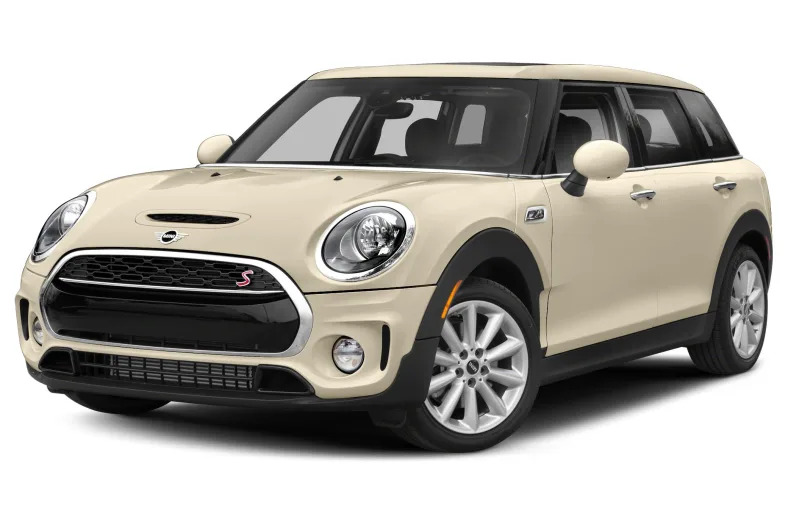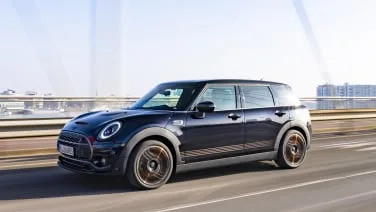Cooper S 4dr ALL4
2019 MINI Clubman
MUNICH, Germany — A battery-electric Mini SE? Haven't we been here before? Well, yes: A decade ago, as part of its "i Project," BMW conducted a worldwide field trial of some 750 lithium-ion battery equipped two-door Mini Coopers. It was launched at the 2008 L.A. Show, and the lithium-ion battery pack took up most of the space normally occupied by the rear seats. Nevertheless, interest in the 450 lease vehicles offered in the U.S. (at $850 a month) was strong, with more demand than cars available. One result of the 2008-2011 trial was parent company BMW learned that the average owner of a two-door Mini drives about 25 miles a day, and the company is hoping the battery Mini will be an ideal (sub)urban-run-around for two- or three-car families. Now BMW is about to launch a production Mini EV (based on the two-door model, but with the full complement of four seats), which goes on sale at the end of the year. This will join the Mini Countryman All4 plug-in hybrid in the electrified Mini stable, but while the Countryman has an EV range of about 12 miles, this battery Mini will travel around 120 miles on a single charge. The reason we can't be too definite about the new Mini's capabilities is that BMW isn't allowed to "advertise" the car this far in front of its on-sale date. We caught up with the prototype model, mummified in camouflage tape, at an off-the-road driving event held at BMW's Munich driving center on the former military air base of Fürstenfeldbruck, now known as Maisach. The drivetrain is based on the middle model of BMW's i3 range, the i3S, with its 135 kilowatt/181 horsepower motor and 94 amp-hour, 33 kilowatt hour battery. The battery is a 96-cell lithium-ion unit from Chinese supplier CATL instead of BMW's previous supplier, Samsung, and it weights 441 pounds. Unlike the team-built, mainly carbon-fiber i3, the Mini is a standard three-door model that runs down the production line in Oxford, with a metal subframe that houses the electric motor, inverter, transformers, and control electronics so they can be slotted into place like a conventional driveline. We can extrapolate a few things about the Mini from the BMW i3S. As well as its working range of 120 miles, the i3S has a top speed of 100 mph and will accelerate from 0-62 mph in 7.7 seconds. With over 360 pounds more to pull about, the 2,998-pound Mini EV will be slower, with less range, especially if used in cold conditions. Understandably Mini is cagey about pricing but says it will sell at a "competitive price against the Cooper S automatic," according to a spokesperson. Recharging time is calculated at about 40 minutes for an 80 percent fill when connected to a 50 kilowatt D/C charger, three hours on an 11.2 kilowatt A/C charger and about 12 hours if you use a standard household supply. From the outside, there's little to differentiate the electron-powered Mini from a standard Cooper. …
Full Review
MUNICH, Germany — A battery-electric Mini SE? Haven't we been here before? Well, yes: A decade ago, as part of its "i Project," BMW conducted a worldwide field trial of some 750 lithium-ion battery equipped two-door Mini Coopers. It was launched at the 2008 L.A. Show, and the lithium-ion battery pack took up most of the space normally occupied by the rear seats. Nevertheless, interest in the 450 lease vehicles offered in the U.S. (at $850 a month) was strong, with more demand than cars available. One result of the 2008-2011 trial was parent company BMW learned that the average owner of a two-door Mini drives about 25 miles a day, and the company is hoping the battery Mini will be an ideal (sub)urban-run-around for two- or three-car families. Now BMW is about to launch a production Mini EV (based on the two-door model, but with the full complement of four seats), which goes on sale at the end of the year. This will join the Mini Countryman All4 plug-in hybrid in the electrified Mini stable, but while the Countryman has an EV range of about 12 miles, this battery Mini will travel around 120 miles on a single charge. The reason we can't be too definite about the new Mini's capabilities is that BMW isn't allowed to "advertise" the car this far in front of its on-sale date. We caught up with the prototype model, mummified in camouflage tape, at an off-the-road driving event held at BMW's Munich driving center on the former military air base of Fürstenfeldbruck, now known as Maisach. The drivetrain is based on the middle model of BMW's i3 range, the i3S, with its 135 kilowatt/181 horsepower motor and 94 amp-hour, 33 kilowatt hour battery. The battery is a 96-cell lithium-ion unit from Chinese supplier CATL instead of BMW's previous supplier, Samsung, and it weights 441 pounds. Unlike the team-built, mainly carbon-fiber i3, the Mini is a standard three-door model that runs down the production line in Oxford, with a metal subframe that houses the electric motor, inverter, transformers, and control electronics so they can be slotted into place like a conventional driveline. We can extrapolate a few things about the Mini from the BMW i3S. As well as its working range of 120 miles, the i3S has a top speed of 100 mph and will accelerate from 0-62 mph in 7.7 seconds. With over 360 pounds more to pull about, the 2,998-pound Mini EV will be slower, with less range, especially if used in cold conditions. Understandably Mini is cagey about pricing but says it will sell at a "competitive price against the Cooper S automatic," according to a spokesperson. Recharging time is calculated at about 40 minutes for an 80 percent fill when connected to a 50 kilowatt D/C charger, three hours on an 11.2 kilowatt A/C charger and about 12 hours if you use a standard household supply. From the outside, there's little to differentiate the electron-powered Mini from a standard Cooper. …
Hide Full Review
Hide Full Review
Retail Price
$30,900
MSRP / Window Sticker Price
| Engine | 2.0L I-4 |
| MPG | 21 City / 30 Hwy |
| Seating | 5 Passengers |
| Transmission | 6-spd man w/OD |
| Power | 189 @ 5000 rpm |
| Drivetrain | ALL4 all wheel |
Smart Buy Program is powered by 





